![]()
![]()
![]()
Use LEFT and RIGHT arrow keys to navigate between flashcards;
Use UP and DOWN arrow keys to flip the card;
H to show hint;
A reads text to speech;
96 Cards in this Set
- Front
- Back
|
What is sensation |
Process where a stimulation of receptor cells in the body send nerve impulses to the brain where they r detected as touch, sound, taste, colour |
|
|
What is perception |
Process where the brain interprets the sensations that it receives giving them meaning and order
|
|
|
What are sence receptors |
Cells that r located in sence organs Convert physical energy in the environment or body to electrical energy that us transmitted as nerve impulses to the brain |
|
|
What are doctrine of specific nerve energies |
Refers to the principle that different sensory modalities exist because signal received by sense organs stimulate different nerve pathways leading to different areas of the brain |
|
|
What is synesthesia |
Condition were stimulation of one sence also makes a sensation in another Sensory crossover |
|
|
What is a stimulus |
Any form of energy to which an organism is capable of responding |
|
|
What is transduction |
Process that a sense organs converts energy from environmental events into neural activity |
|
|
What is quality |
Refers to the kind of sensation the stimulus produces |
|
|
What is quantity |
Refers to the amount of a stimulus |
|
|
What is psychophysics |
Concerned with how the physical properties of a stimuli are related to our psychological experience of them Relies on measuring absolute threshold, difference threshold, applying signal detection theory |
|
|
What is absolute threshold |
Smallest quantity of physical energy that can be reliably detected by an observer |
|
|
What is difference threshold |
Smallest difference in stimulation that can reliably be detected by an observer when 2 stimuli are compared (Just noticeable difference (JND)) |
|
|
What is signal detection theory |
Divides the detection of sensory signals into a sensory process and a decision process -influences by observers response bias |
|
|
What is sensory adaptation |
Reduction or disappearance of sensory responsiveness when stimulation is unchanging |
|
|
What is sensory deprivation |
Absence of normal levels of sensory stimulation -responses vary dependant on expectations and interpretations |
|
|
What is selective attention |
Focusing of attention on selected aspects of the environment and blocking out the others |
|
|
What is inattentinal blindness |
Failure to consciously perceives something you are looking at because you are not attending to it |
|
|
What are the 5 basic sneces |
Vision Audition (hearing) Taste (gustation) Smell (olfaction) Sense of the skin |
|
|
What is light |
Basic stimulus of vison Travels in wave like patterns instead of straight lines |
|
|
What are photons |
elementary particles of light radiation |
|
|
What is a wavelength |
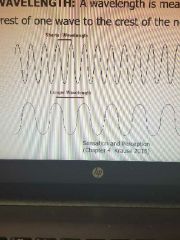
Is measured from the crest of one wave to the crest of the next wave |
|
|
What are the 3 dimensions of colour |
Hue- determined by wavelength Brightness/intensity- corresponds to the amplitude of wave Saturation(vividness)- complexity of light waves |
|
|
What is the cornea, aqueous humour, iris, pupil, lens |
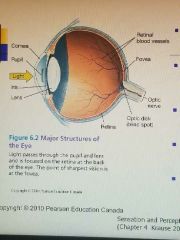
Cornea-Protects the eye and bends light towards lens Aqueous humour- maintains rounded shape of the cornea iris- controls amount of light into the eye Pupil- widens or dilated to let more light in Lens- focused on objects by changing shape |
|
|
The retina |
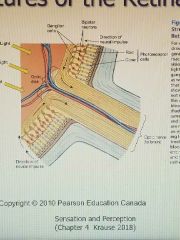
|
|
|
Optic chiasm |
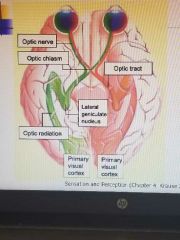
|
|
|
What are the rhodopsin and iodopsin |
-pigment in the rods Pigment in the cones |
|
|
What is trichromatic theory |
-young/Helmholtz 3 different kinds of cones Blue-sensitive to short wave light Green-sensitive to medium wave light Red-sensitive to long wave light |
|
|
What are afterimages |
Visual impression that persist after removal of the stimuli that originally produced it Different colours then original image |
|
|
What is opponent process theory |
-hering/ hurvich and Jameson Helped to account for afterimages - assumes that the visual system treats pairs of colors as opposing or antagonistic (Red/green) (Blue/yellow) (White/black) |
|
|
Trichromatic and opponent process theory are different levels of the visual system |
Trichromatic- applies at the level of the receptor cells Oponent- applies at the level of the brain |
|
|
Color blindness |
Protanapia (sees more red then green) Deuteranopia (more green then red) Trutanopia (more blue then yellow) |
|
|
What are the 4 aspects of perception |
1) firm perception 2)depth and distance perception 3)perceptual constancy 4)visual illusions |
|
|
What is form perception |
The detection or perception of unified pattern from a mass of sensory data |
|
|
What are the gestalt principles of perceptual grouping (5) |
1) figure/ground The division of stimuli into figure and ground Separation of regions |
|
|
2) |
Proximity Stimuli that are near each other tend to be perceived as a group |
|
|
3) |
Closure Supplies missing info and closes the outline of an incolple figure |
|
|
4) |
Similarity Object perceived as groups if they are similar in so dimension (shape,color) |
|
|
5) |
Continuity Stimuli that form a single continuous groups are seen as a whole |
|
|
What is depth and distance perception |
Our ability to see the visual world in 3 dimensions |
|
|
What are binocular cues and monocular cues |
-Visual cues to depth or distance perception requiring 2 eyes -used by 1 eye |
|
|
Binocular cues What is convergence |
The turning of the eyes inward when the focus in a nearby object The closer the greater |
|
|
Binocular cues Binocular or retinal disparity |
The slight difference in lateral separation between 2 objects as seen by the left and right eye |
|
|
What are the monocular cues (8) |
1) motion parallax Objects appear to move at different spears and in different directions Objects closer move after |
|
|
2) |
Relative size Think 2 objects are the same size, we perceive then one casting the smaller retinal image to be further away |
|
|
3) |
Relative closeness to the horizon Closer to horizon the more distance |
|
|
4) |
Linear perspective Produced by the apparent convergence of parallel lines as the recede into distance |
|
|
5) |
Texture gradient Near objects appear coarser and more distance apperear finer |
|
|
6) |
Interpolation or partial overlap Object partly blocks another we perceive the object that is blocked as farther away |
|
|
7) |
Relative clarity Because of particles in the air, distant objects tend to look hazier |
|
|
8) |
Light and shadow Give objects the appearance of three dimensions |
|
|
What is perceptual constancy |
Tendency to see the world as consisting of objects with stable properties even though the visual images we receive are constantly changing |
|
|
What are the 5 perceptual constancy |
Shape constancy Location constancy Size constancy Brightness constancy Color constancy |
|
|
What is muller-lyer illusion |

2 lines the same length but our brain thinks they are different because of the inward and outward branches |
|
|
What are sound waves |
Basic stimulus for hearing |
|
|
What r the 3 dimensions of sound |
Loudness Pitch Tenbre |
|
|
What is loudness |
Amplitude -messed in its if decibels (db) - the intensity of a sound wave -distance of waves peaks and valleys from a baseline of zero |
|
|
What is pitch |
Frequency=wavelength -number of confession rarefaction cycles per second Hertz (Hz) -one cylc per second equals 1 hertz |
|
|
What is timbre |
Complexity of the sound wave - the relative breadth of the range of frequencies that make up the wave -a particular combination of frequencies results in a particular timbre |
|
|
Parts of the ear |
Outer ear Middle ear Inner ear |
|
|
Parts if the outer ear |
Pinna Auditory canal Eardrum (tympanic membrane) |
|
|
Parts of the middle ear |
Malleus (hammer) Incus (anvil) Stapes (stirrup) Oval window |
|
|
Parts if the inner ear |
Cochlea (organ of corti) Hair cells (cilia) Basilar and tectotial membranes |
|
|
The ear |
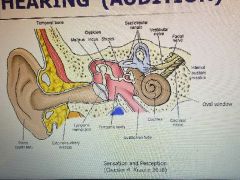
|
|
|
Why are patterns of sound organized |
To construct meaningful patterns -gestalt principles can apply to sound perception |
|
|
What is sound localization |
Relative loudness Difference in a rival time at Each eardrum |
|
|
What are taste precptors made of |
Papillae -Taste buds ~microvilli |
|
|
Send a of taste |

|
|
|
What are the 5 qualities of taste |
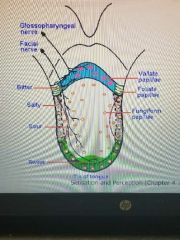
Sourness Sweetness Saltiness Bitterness Umami |
|
|
What does the olfactory mucosa have |
Receptor cells for smell -not appear to be the primary dimensions for odor |
|
|
Smell |
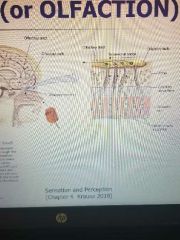
|
|
|
What is the sense if skin for |
Temperature Pressure Pain |
|
|
Temperature |
Differn3t sensory ending for the sensations of warmth and coolness Detectors respond best to changes in the temperature |
|
|
Pressure/touch |
Sensations of pressure happen only when skin is actually moving |
|
|
Pain |
Pain is both sensory and emotional component |
|
|
What are the 2 kinds of pain |
Bright or sharp pain Deep and dull pain |
|
|
What are the 2 theories of pain |
Gate control theory Neutomatrix theory |
|
|
What is gate control theory |
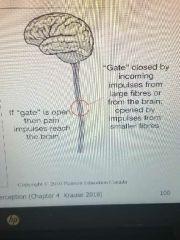
The experience of pain depends in part on whether pain impulses get part a neurological gate in the spinal cord and reach the brain |
|
|
What is neutomatrix theory |
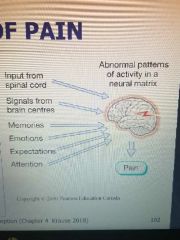
Matrix of neurons in the brain is capable of generating pain in the absence of signals from the sensory nerves Accounts for phantom pain |
|
|
What is language |
A system yhat combined meaninhless elmets of sound or gestures to form structured utteranced that convey meaning |
|
|
What are the 5 elemts of langue |
1) phoneme The simplest unit of language. Single speech sound such as a vowel or consonant |
|
|
2) |
Morpheme A unit of meaing in a language Combine of phonemes to make morphemes |
|
|
3) |
Semantics The study of how people come to understand the meaning from words |
|
|
4) |
Syntax Grammar of language Rules for combining words into meaningful phrases and sentences |
|
|
5) |
Pragmatics Study of nonlinguistic events of language use Emphasized the speakers behaviours and the social situation |
|
|
What us surface structure |
The way a sentence is actually spoken or signed |
|
|
What is deep structure |
How a sentence is to be understood |
|
|
What us the brocas area and wernickes area invoved in |
Brocas- language production Wernickes- language comprehension |
|
|
What is the evidence for sensitive periods for language development |
Differences in effects of head injuries on language, depending on age when the head injury happened |
|
|
What are the costs and benefits of bilingualism |
Costs -smaller vocabulary -word access Benefits -executive functions - Health benefits |
|
|
People and the animals learning language |
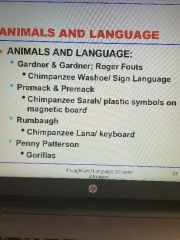
|
|
|
What are the theories of language |
Behavioral theory -reienforcemnt -imitation Social learning theory -observational learning -imitation |
|
|
What are the theories of language development |
Chomsky (innate capacity for language) -language acquisition device -universal grammar Lenneberg (biological aspects of language acquisition) -critical period for language acquisition |
|
|
What are the 5 supporting evidence for chomskys theory |
1)cross cultural similarities in language development 2)overregularizations 3)adults don't consistently correct their children's syntax yet children learn to speak right 4)childnt not exposed to adult language .ight invent their own language 5)infants (as young 7 months) can derive simple linguistic rules from a sting of sounds |
|
|
What is the 6 supporting evidence for linnebergs theory |
1)language is a form of behavior present in all cultures 2)all cultures the onset of language is the correlated 3)there is only 1 acquisition strategy for language and it is the same for all babies 4) form of behaviour that may be impaired specifically by circumscribed brain lesions 5) high correlation between motor development and lounge development 6) language acquisition is related to brain maturation |
|
|
According to lenneberg |
There is a critical period for language acquisition Evidence from age related differences in the recovery from head injury |
|
|
What are computer neural networks |
Are mathematical models of the brain that can learn some aspects of language (like regular and irregular part tense verbs) without help of a language acquisition device or biologically prewired rules |

